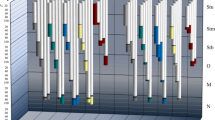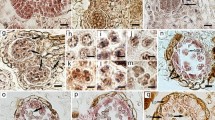Summary
A research has been carried out on possible differences in developmental rate or growth rate of ovules, embryos and endosperms after prickle pollination and after selfing of Brassica oleracea plants. After prickle pollination ovules, embryos and endosperms developed/grew slower than after selfing which may be attributed to certain disturbances in the embryosac. After prickle pollination embryos and endosperms occurred with possible a rather high ploidy level suggesting that diploid embryosacs were present.
Similar content being viewed by others
References
Böcher, T. W., 1951. Cytological and embryological studies in the amphiapomictic Arabis Holoboellii complex. K. danske Vidinsk. Selsk. Biol. Skr. 6: 1–59.
Brink, R. A. & D. C. Cooper, 1974. The endosperm in seed development. Bot. Rev. 13, No. 8/9.
Conn, H. J., 1940. Biological stains. Biotech. Public., Geneva, N.Y.
Cooper, D. C. & R. A. Brink, 1940. Somatoplastic sterility as a cause of seed failure after interspecific hybridization. Genetics 25: 593–615.
Eenink, A. H., 1974a. Matromorphy in Brassica oleracea L. II. Differences in parthenogenetic ability and parthenogenesis inducing ability. Euphytica 23: 435–445.
Eenink, A. H., 1974b. Matromorphy in Brassica oleracea L. III. The influence of temperature, delayed prickle pollination and growth regulators on the number of matromorphic seeds formed. Euphytica 23: 711–718.
Eenink, A. H., 1974c. Matromorphy in Brassica oleracea L. IV. Formation of homozygous and heterozygous diploid products of gametogenesis and qualitative genetical research on matromorphic plants. Euphytica 23: 719–724.
Eenink, A. H., 1974d. Matromorphy in Brassica oleracea L. V. Studies on quantitative characters of matromorphic plants and their progeny. Euphytica 23: 725–736.
Flemming, W., 1891. Uber Teilung und Kernformen bei Leukocyten und über denen Attractionssphären. Arch. mikrosk. Anat. 37: 249–298.
Guha, S. & S. C. Maheshwari, 1964. In vitro production of embryos from anthers of Datura. Nature 204: 497.
Håkansson, A., 1953. Endosperm formation after 2x, 4x crosses in certain cereals, especially in Hordeum vulgare. Hereditas 39: 57–64.
Harberd, D. J., 1969. A simple effective embryo culture technique for Brassica. Euphytica 18: 425–429.
Heyn, F. W., 1973. Beiträge zum Auftreten unreduzierter Gameten und zur Genetik einiger Merkmale bei den Brassiceae. Georg-August Universität, Göttingen.
Howard, H. W., 1939. The size of seeds in diploid and autotetraploid Brassica oleracea L. J. Genet. 38: 325–340.
Howard, H. W., 1942. The effect of polyploidy and hybridity on seed in crosses between Brassica chinensis, B. carinata, amphidiploid B. chinensis-carinata and autotetraploid B. chinensis. J. Genet. 43: 105–119.
Howard, H. W., 1947. Seed size in crosses between diploid and autotetraploid Nasturtium officinale and allotetraploid N. uniseriatum. J. Genet. 48: 111–118.
Katayama, Y., 1933. Crossing experiments in certain cereals with special reference to different compatibility between the reciprocal crosses. Mem. Coll. Agric. Kyoto Imp. Univ. 27: 1–75.
Kihara, H., 1940. Formation of haploids by means of delayed pollination in Triticum monococcum. Bot. Mag. 54: 178–185.
Mackiewicz, T., 1973. Fertilization, endosperm and embryo development in Brassica oleracea var. capitata L. x B. oleracea var. acephala DC. hybrid as compared with the parental forms. Genet. Polonica 14: 11–19.
Maheshwari, P., 1950. An introduction to the embryology of Angiosperms. McGraw-Hill, New York.
Müntzing, A., Hybrid incompatibility and the origin of polyploidy. Hereditas 18: 33–55.
Neumann, M., 1973. Zur postgamen Inkompatibilität bei Brassica. Archiv. für Züchtungsforschung 3: 133–140.
Nishi, S. & T. Hiraoka, 1962. A cytological study of embryo development in Brassica campestris L. var. Komatsuna caused by pseudogamy. Bull. hort. Res. Stn Japan, Ser. A. 1: 95–110.
Nishi, S., T. Kuriyama & T. Hiraoka, 1964. Studies on the breeding of crucifer vegetables by interspecific and intergeneric hybridization. Bull. hort. Res. Stn Japan, Ser. A. 3: 161–250.
Noack, K. L., 1939. Über Hypericum-Kreuzungen VI. Fortpflanzungsverhältnisse und Bastarde von Hypericum perforatum L. Z. indukt. Abstamm. −und Vererblehre 76: 569–601.
Rutishauser, A. & L. F. LaCour, 1956a. Spontaneous chromosome breakage in endosperm. Nature 177: 324–325.
Rutishauser, A. & L. F. laCour, 1956b. Spontaneous chromosome breakage in hybrid endosperms. Chromosoma 8: 317–340.
Rutishauser, A., 1967. Protoplasmatologia. Handbuch der Protoplasmaforschung. Springer-Verlag, Wien-New York.
Rutishauser, A., 1969. Embryologie und Fortpflanzungsbiologie der Angiospermen. Springer-Verlag, Wien-New York.
Skiebe, K., 1958. Die Bedeutung von unreduzierten Gameten für die Polyploidiezüchtung bei der Fliederprimel (Primula malacoides Franchet). Züchter 28: 353–359.
Skiebe, K., 1973. Genetische Voraussetzungen für die Samenbildung nach intergenomatisch verschiedenen Kreuzungen. Archiv für Züchtungsforschung 3: 183–202.
Stettler, R. F. & K. S. Bawa, 1971. Experimental induction of haploid parthenogenesis in black cottonwood. Silvae Genetica 20: 15–25.
Tokumasu, S., 1965. On the origin of matromorphic plants of Brassica japonica obtained from the cross between Brassica and Raphanus. J. Japan. Soc. hort. Sci. 34: 223–231.
Thompson, R. C., 1933. A morphological study of flower and seed development in cabbage. J. agric. Res. 47: 215–232.
Thompson, W. P. & D. Johnston, 1945. The cause of incompatibility between barley and rye. Can. J. Res. 23: 1–15.
Wangenheim, K. H. von, S. J. Peloquin & R. W. Hougas, 1960. Embryological investigations on the formation of haploids in the potato (Solanum tuberosum). Zeitschr. Vererbungslehre 91: 391–399.
Wangenheim, K. H. von, 1961. Zur Ursache der Abortion von Samenanlagen in diploid-polyploid Kreuzungen. Z. PflZücht. 46: 13–19.
Wardlaws, C. W., 1955. Embryogenesis in plants. Methuen & Co, London.
Watkins, A. E., 1932. Hybrid sterility and incompatibility. J. Genet. 25: 125–162.
Author information
Authors and Affiliations
Rights and permissions
About this article
Cite this article
Eenink, A.H. Matromorphy in Brassica oleracea L. VI. Research on ovules, embryos and endosperms after prickle pollination. Euphytica 24, 33–43 (1975). https://doi.org/10.1007/BF00147166
Received:
Issue Date:
DOI: https://doi.org/10.1007/BF00147166




